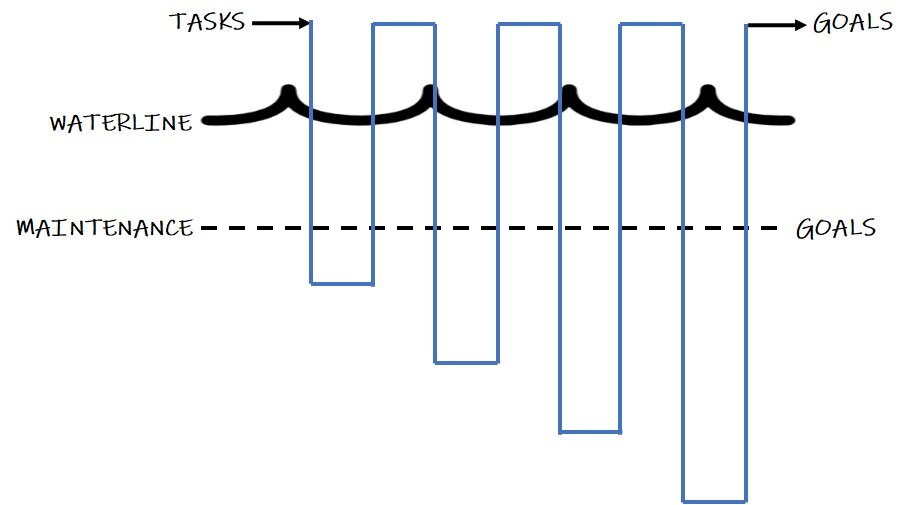Peopling 101: The Waterline Model
Image Credit: unknown
What is it? The Waterline Model is simple diagnostic tool for understanding and addressing various breakdowns in communication and team dynamics.
The Basics
When individuals form groups or teams form, they have a goal in mind—at a personal level and as a collective.
Seems simple, right? Not when people are involved. At some point, there will be friction, misunderstanding, and crossed wires. Conflict will happen. The meeting gets derailed. Whatever happened, progress is no longer smooth.
You’re stuck. What’s really happening? There’s actually a LOT more going on beneath the water.
The task is only one half, the half that is concrete and above the water. Below the water, are many maintenance activities that people forget to pay attention to, and it costs them in time, money, and quality of their goal.
TASK FUNCTIONS
Developing the Agenda
Initiating
Information Seeking
Information Giving
Opinion Giving
Elaborating
Coordinating
Evaluating
Energizing
Structuring
Summarizing
Consensus Testing
Reality Testing
MAINTENANCE FUNCTIONS
Gate keeping
Encouraging
Harmonizing
Consensus Seeking
Giving and Receiving Feedback
Standard Setting
Tension Relief
Expressing Group Feelings / Perceptions
Processing
There are four parts to the model:
Structure
Group Norms
Interpersonal Issues
Intrapersonal Issues
Simple, right? Lack of attention to maintenance creates muddy waters and stuckness. Along with the TASK and MAINTENANCE behaviors, people will also engage in dysfunctional behaviors, like:
Blocking
Power Seeking / Power Struggles
Recognition Seeking
Hoarding information / Avoiding collaboration
Destructive Competition
Dominating
Excessive Clowning
Silence, Prolonging Tasks, Others…
Key Concepts
1. STRUCTURE: Roles & Goals
The vast majority of team and organizational strife is due to a lack of alignment on goals or roles, unclear leadership, a lack of clarity about authority and decision making, ineffective patterns of communication, or a lack of trust and accountability.
Symptoms:
Confusion about the task or goal
Confusion about you role in accomplishing it
Disagreement about the task or goal
Disagreement about your role
Diagnostic questions to consider:
Do all members share (and can they articulate) the primary goal?
Can members get answers to questions easily, or is a committee needed to make the decision on numerous routine questions?
Is it clear what decision-making style is being used, and when?
2. GROUP NORMS: Dynamics & Development
The vast majority of team and organizational strife is due to a lack of alignment on goals or roles, unclear leadership, a lack of clarity about authority and decision making, ineffective patterns of communication, or a lack of trust and accountability.
Symptoms:
Participation is lopsided
Influence is lopsided
Members aren’t sure if a decision has been made or not
People are “included” from the group.
The group relies too much on the leader
People don’t offer their experience to the group
Diagnostic questions to consider:
What is participating and influencing, and who is not?
How is conflict being handled?
Does the group accomplish tasks effectively?
Do the norms of the group embody the values of its members? Can members (or leaders) identify what the group ‘norms’ are?
–Are these norms consistent?
–Are the norms supportive or challenging to the accomplishment of the goals?
Are there ‘silent’ members whose contribution is not clear or being maximized?
When a decision is made, is the group clear what it actually was?
Are “group” problems masking unclear “Roles”
PARTICIPATORY MANAGEMENT
DECISION-MAKING STYLES
AUTOCRATIC
Decide & Tell
Style #1 - autocratic
Decide unilaterally and announce decision.
Ask for paraphrase to make sure you have been clear.
CONSULTATIVE
Decide after consultation and/or recommendation.
Style #2 - consult
Almost decided, check reactions before final decision.
Style #3 - recommend
Solicit inputs before deciding.
GROUP DECISION
Followers share in decision.
Style #4 - majority
Majority vote with leader having one vote … no veto power.
Style #5 - consensus
All agree after discussion.
DELEGATION
Delegation of decision with clear parameters.
Style #6 - delegation
Delegate the decision with clear parameters of freedom.
Ask for paraphrase to make sure clear.
3. INTERPERSONAL (Between 2 people.)
Symptoms
Members misunderstand or make assumptions about others’ experience
Communications are not finished
Conflict and differences are avoided
People don’t give or solicit feedback
Diagnostic Questions to consider:
Do members paraphrase and perception check with each other?
Do interactions get finished or interrupted?
Is conflict managed effectively?
Is feedback given and received freely?
Is feedback given and received effectively?
Do members learn from their experience?
4. INTRA-PERSONAL. (Within an individual.)
Symptoms:
You/someone is distracted from the focus of the group
You/someone’s skill level, values, or biases prevent them from working on the task effectively.
You/someone isn’t learning from their experience with others
Diagnostics to consider:
Is there something going on that distracts the individual or team? (family, illness, RIFs)
Do members have the skill required to accomplish their tasks?
Is someone’s personal belief, values, or self-assessment of skill/role a barrier to flexibility within the team?
Is there a language barrier hampering effective communication?
Do I report my here-and-now experience?
Do I inquire about others’ here-and-now experience?
Do I learn from my experience with others?
SUMMARY
Reference: There are many interpretations of the Waterline Model. The model discussed here is based on Roger Harrison’s article “Choosing the Depth of Organizational Intervention,” published in the Journal of Applied Behavioral Science in 1970.






